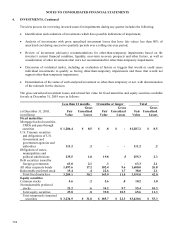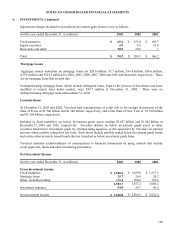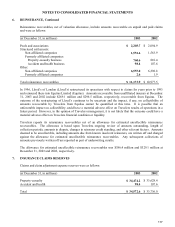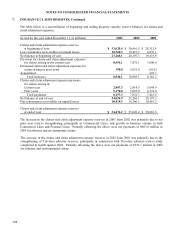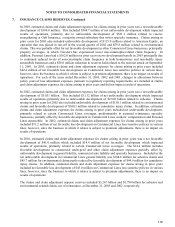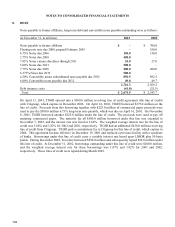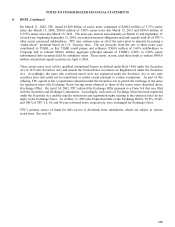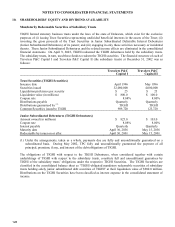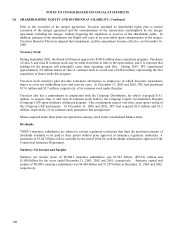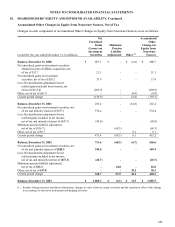Travelers 2003 Annual Report Download - page 123
Download and view the complete annual report
Please find page 123 of the 2003 Travelers annual report below. You can navigate through the pages in the report by either clicking on the pages listed below, or by using the keyword search tool below to find specific information within the annual report.121
NOTES TO CONSOLIDATED FINANCIAL STATEMENTS
7. INSURANCE CLAIMS RESERVES, Continued
In establishing environmental reserves, Travelers evaluates the exposure presented by each policyholder and the
anticipated cost of resolution, if any. In the course of this analysis, Travelers considers the probable liability,
available coverage, relevant judicial interpretations and historical value of similar exposures. In addition,
Travelers considers the many variables presented, such as the nature of the alleged activities of the policyholder
at each site; the allegations of environmental harm at each site; the number of sites; the total number of
potentially responsible parties at each site; the nature of environmental harm and the corresponding remedy at
each site; the nature of government enforcement activities at each site; the ownership and general use of each
site; the overall nature of the insurance relationship between Travelers and the policyholder, including the role of
any umbrella or excess insurance Travelers has issued to the policyholder; the involvement of other insurers; the
potential for other available coverage, including the number of years of coverage; the role, if any, of non-
environmental claims or potential non-environmental claims, in any resolution process; and the applicable law in
each jurisdiction. Conventional actuarial techniques are not used to estimate these reserves. Net environmental
losses paid were $155.2 million, $160.6 million and $207.6 million for the years ended December 31, 2003,
2002 and 2001, respectively.
As a result of the processes and procedures described above, management believes that the reserves carried for
asbestos and environmental claims at December 31, 2003 are appropriately established based upon known facts,
current law and management’s judgment. However, the uncertainties surrounding the final resolution of these
claims continue, and it is presently not possible to estimate the ultimate exposure for asbestos and environmental
claims and related litigation. As a result, the reserve is subject to revision as new information becomes available
or as information is reevaluated in light of evolving circumstances. The continuing uncertainties include,
without limitation, the risks and lack of predictability inherent in major litigation, any impact from the
bankruptcy protection sought by various asbestos producers and other asbestos defendants, a further increase or
decrease in asbestos and environmental claims which cannot now be anticipated, the role of any umbrella or
excess policies Travelers has issued, the resolution or adjudication of some disputes pertaining to the amount of
available coverage for asbestos claims in a manner inconsistent with Travelers previous assessment of these
claims, the number and outcome of direct actions against Travelers, and future developments pertaining to
Travelers ability to recover reinsurance for asbestos and environmental claims. It is also not possible to predict
changes in the legal and legislative environment and their impact on the future development of asbestos and
environmental claims. This development will be affected by future court decisions and interpretations, as well as
changes in applicable legislation. It is also difficult to predict the ultimate outcome of large coverage disputes
until settlement negotiations near completion and significant legal questions are resolved or, failing settlement,
until the dispute is adjudicated. This is particularly the case with policyholders in bankruptcy where negotiations
often involve a large number of claimants and other parties and require court approval to be effective.
In March 2002, Citigroup entered into an agreement under which it provided Travelers with financial support for
asbestos claims and related litigation, in any year that Travelers insurance subsidiaries record asbestos-related
income statement charges in excess of $150.0 million, net of any reinsurance, up to a cumulative aggregate of
$800.0 million, reduced by the tax effect of the highest applicable federal income tax rate. During 2002,
Travelers recorded $2.945 billion of asbestos incurred losses, net of reinsurance, and accordingly has fully
utilized the total benefit available under the agreement.
Because of the uncertainties set forth above, additional liabilities may arise for amounts in excess of the current
related reserves. In addition, Travelers estimate of ultimate claims and claim adjustment expenses may change.
These additional liabilities or increases in estimates, or a range of either, cannot now be reasonably estimated
and could result in income statement charges that could be material to Travelers operating results and financial
condition in future periods.



